
Parietin is the predominant cortical pigment of lichens in the genus Caloplaca, a secondary product of the lichen Xanthoria parietina, and a pigment found in the roots of curled dock. It has an orange-yellow color and absorbs blue light.

The Teloschistaceae are a large family of mostly lichen-forming fungi belonging to the class Lecanoromycetes in the division Ascomycota. The family has a cosmopolitan distribution, although members occur predominantly in temperate regions. Most members are lichens that either live on rock or on bark, but about 40 species are lichenicolous – meaning they are non-lichenised fungi that live on other lichens. Many members of the Teloschistaceae are readily identifiable by their vibrant orange to yellow hue, a result of their frequent anthraquinone content. The presence of these anthraquinone pigments, which confer protection from ultraviolet light, enabled this group to expand from shaded forest habitats to harsher environmental conditions of sunny and arid ecosystems during the Late Cretaceous.

Xanthoria is a genus of lichenized fungi in the family Teloschistaceae. Common names include orange lichen, orange wall lichen, and sunburst lichen. They can be identified by their characteristic squamulose morphology with distinctive "fairy cups".

Athallia is a genus of lichen-forming fungi in the family Teloschistaceae. It was circumscribed in 2013 by Ulf Arup, Patrik Frödén, and Ulrik Søchting, and the type species is Athallia holocarpa. The genus name means "without a thallus".
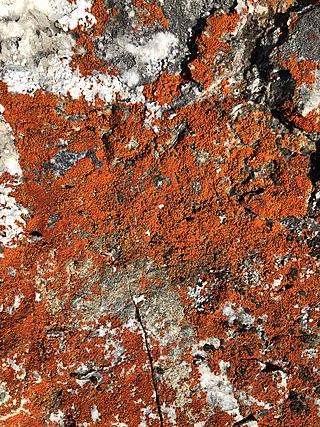
Igneoplaca is a genus in the subfamily Xanthorioideae of the family Teloschistaceae. It contains a single species, the crustose lichen Igneoplaca ignea.
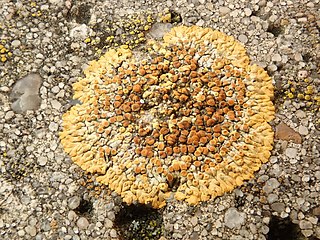
Calogaya pusilla is a species of saxicolous (rock-dwelling), crustose lichen in the family Teloschistaceae. It was originally formally described in 1852 by Italian lichenologist Abramo Bartolommeo Massalongo, who placed it in genus Physcia. The type specimen was collected in Veneto, Italy. It has undergone several changes of genus in its taxonomic history, including transfers to Caloplaca, Placodium, and Teloschistes. In 2013, it was placed in the newly circumscribed genus Calogaya.
Solitaria is a fungal genus in the family Teloschistaceae. It contains a single species, the corticolous (bark-dwelling), crustose lichen Solitaria chrysophthalma.
Usnochroma is a genus of lichen-forming fungi in the family Teloschistaceae. It has two species of crustose lichens. The genus was circumscribed in 2013 by lichenologists Ulrik Søchting, Ulf Arup, and Patrik Frödén, with Usnochroma carphineum assigned as the type species. The genus name refers to the yellowish-green colour of the thallus, which is caused by the substance usnic acid. Usnochroma species occur in Macaronesia, South Africa, the Mediterranean Basin, and Algeria.
Charcotiana is a single-species genus in the family Teloschistaceae. It contains the species Charcotiana antarctica, a crustose lichen found in Antarctica.
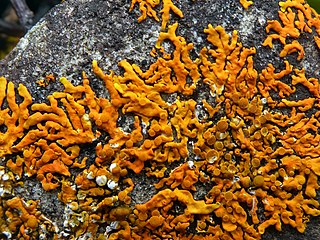
Dufourea ligulata is a species of saxicolous (rock-dwelling), foliose lichen in the family Teloschistaceae. The German lichenologist Gustav Wilhelm Körber first formally described the species in 1862, as a member of the genus Physcia. Patrik Frödén, Ulf Arup, and Ulrik Søchting transferred it to the genus Dufourea in 2013 as part of a molecular phylogenetics-based restructuring of the family Teloschistaceae.
Sirenophila maccarthyi is a species of corticolous/lignicolous, crustose lichen in the family Teloschistaceae. It has a thallus that is whitish or greyish, often inconspicuous and not always continuous, which can appear darker or dirty grey near its numerous, clustered apothecia. Sirenophila maccarthyi is distributed across regions including Western Australia, New South Wales, Victoria, Tasmania, and New Zealand, in both coastal and inland habitats. It typically grows on the bark and dead wood of a wide range of trees and shrubs such as Acacia sophorae, Araucaria excelsa, and various Eucalyptus species.

Polycauliona coralloides, the coral firedot lichen, is a species of small fruticose (bushy), saxicolous (rock-dwelling) lichen in the family Teloschistaceae. First formally described in 1866, it was later shuffled to a few different genera in its taxonomic history before ending up in Polycauliona, a genus resurrected from taxonomic obscurity in the molecular phylogenetics era. The lichen occurs on seaside rocks in the intertidal spray zone of California and northwestern Mexico. The species is readily recognized due to its distinctive coral-like form–its thallus grows as a tangle of orange, filamentous branches.
Flavoplaca kantvilasii is a species of saxicolous (rock-dwelling), crustose lichen in the family Teloschistaceae. Found in Australia, it was formally described as a new species in 2007.
Flavoplaca arcisproxima is a species of saxicolous (rock-dwelling), crustose lichen in the family Teloschistaceae. It is found primarily in the coastal regions of the Crimean Peninsula and the eastern Mediterranean, particularly in Crete, Greece.
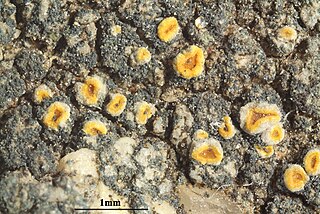
Kuettlingeria soralifera is a saxicolous (rock-dwelling), crustose lichen species in the family Teloschistaceae, first described in 2006. It is similar to Kuettlingeria xerica but distinguished by the presence of soredia on its thallus.
Hanstrassia lenae is a species of saxicolous (rock-dwelling) in the family Teloschistaceae. Described as a new species in 2007, the lichen is found in Russian Far East, Mongolia, and Siberia. It closely resembles Elenkiniana ehrenbergii but distinguished by the presence of soralia on its thallus. This species has a thick, effigurate thallus with weak marginal lobes and developed marginal, labriform (lip-shaped) soralia.
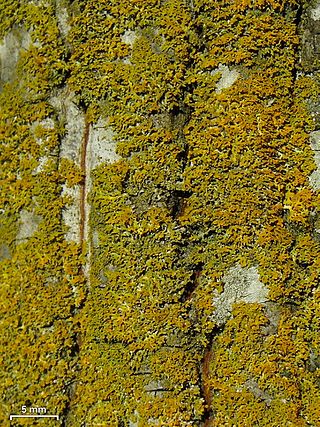
Gallowayella weberi is a species of corticolous and saxicolous, foliose lichen in the family Teloschistaceae. Found in the eastern United States, it is a small lichen with a smooth yellow to orange upper surface and a contrasting white lower surface.
Scutaria is a single-species fungal genus in the family Teloschistaceae. It contains the species Scutaria andina, found in South America. The thallus of this lichen has a form that is intermediate between crustose and foliose.
Austroplaca soropelta is a species of saxicolous and muscicolous, crustose lichen in the family Teloschistaceae. It has a bipolar distribution, meaning it occurs in polar areas of both the Northern and Southern Hemispheres.

Gallowayella borealis is a species of saxicolous and muscicolous, lichen in the family Teloschistaceae. The lichen is characterized by a foliose (leafy) thallus that forms small, cushion-like clusters, with lobes that are often convex and have a distinctive orange colour with a reddish tint, occasionally covered in pruina. It reproduces vegetatively through abundant soralia producing rounded, granule-like soredia. Chemically, it contains high levels of parietin among other lichen products. Gallowayella borealis thrives on both horizontal and vertical rock surfaces, often enriched by guano, and is particularly abundant in continental Antarctica, co-existing with Polycauliona candelaria near penguin rookeries. It has a bipolar distribution, found in the Arctic and boreal forests of the Northern Hemisphere as well as in ice-free zones of continental Antarctica.











